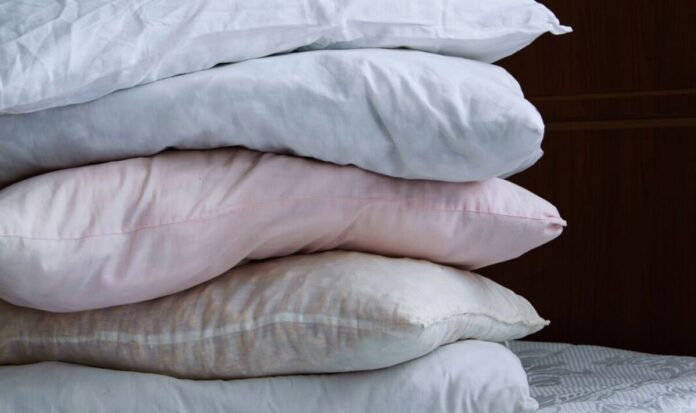Express.co.uk recently spoke to Chris Tattersall, Sleep Expert and Woolroom MD about washing bedding thoroughly to kill bacteria and remove dust mites , and surprisingly, the temperature of the cycle recommended was not 60 or 90 degrees. When it comes to pillows, the expert shared his top tips for knowing when it’s time to replace them, and how to clean them – including removing unsightly yellow stains. Chris said ‘the general rule is to wash pillowcases or covers once a week’ on a 40 degree wash. Washing the pillow itself, ‘like a duvet, is dependent on what the pillow is made from’. He said: ‘Like with your bed sheets and duvets, washing your pillow is important to clear your bedding of dust mites, which are naturally attracted to used bedding. ‘With synthetic and feather/down pillows, to completely rid them of dust mites, they will need to go in the washing machine at 60 degrees. ‘Due to the self-cleaning qualities of wool, however, wool pillows naturally keep bacteria and dust mites at bay meaning washing is not necessary. ‘However, if you do want to wash your wool pillow, washing it at 30 degrees, on a wool cycle with wool detergent will do the trick.’ If you notice your ‘pillow begin to smell, or is stained or turning yellow’, Chris said ‘it may be a result of the sweat from your head’. He explained: ‘Yellow stains occur due to the fibre the pillow is made from – and is an indication either the pillow or the rest of your bedding is not regulating your temperature when you sleep, hence why you sweat.’ Most yellow stains are ‘not reversable’, Chris said, and while you can clean the pillowcases or the pillow itself to remove the sweat, the stain usually remains, and this ‘is a sign for the pillow to be replaced’. Yellow stains on pillows occur due to sweat, wet hair, skincare products (Image: GETTY) There are other ‘obvious signs’ that your pillow might need replacing. Chris said: ‘If your pillow is proving uncomfortable for your head, neck or shoulders, resulting in aches and headaches. ‘Users can test if the time has come for a new pillow by folding it in half and releasing it. Should the pillow ‘spring’ back, it is fine to continue using; if it remains folded, however, it has lost its support and it is time for a new one. ‘I’ve always recommended pillows be replaced every one to two years, as they get worn out surprisingly quickly, more regularly than your duvet.’ If you don’t want to be replacing your pillows every couple of years, or you’re tired of attempting to remove yellow stains from pillowcases and covers, consider changing to wool pillows. Chris explained: ‘Much like a wool duvet and mattress protector, the key benefit of a wool pillow is keeping you cool, as having a cool head at night is crucial for a good night’s sleep. Woolroom’s Deluxe Washable Wool Pillow is the perfect choice for personalised comfort. (Image: WOOLROOM) ‘And due to being cooling, wool pillows do not suffer from turning yellow in the same way as synthetic or feather down pillows and therefore have greater longevity. In fact, wool pillows will last five times longer than synthetic ones. ‘You can also insert a natural cotton or wool pillow protector over your pillow before the pillowcase to help protect them from turning yellow.’ Woolroom’s Deluxe Washable Wool Pillow is the perfect choice for personalised comfort. Being fully adjustable, it offers personalisation by allowing users to add or remove wool depending on preference and is encased in a quilted cover for added comfort and temperature regulation. Like the Classic Pillow , it is also hypoallergenic, but with the added convenience of being fully machine washable and containing wool that is traceable back to the farm from which it came, including the famous Chatsworth Estate in Derbyshire.
Best temperature to ‘completely’ remove dust mites and sweat stains from pillows
Sourceexpress.co.uk
RELATED ARTICLES


